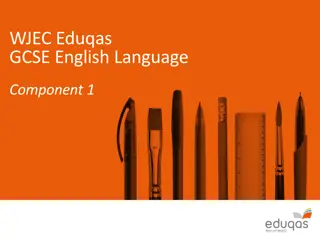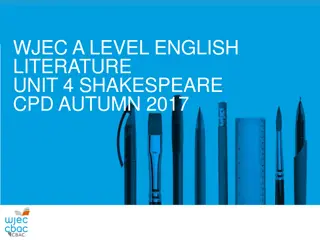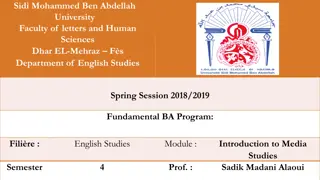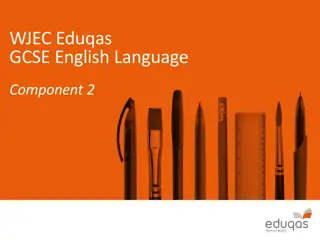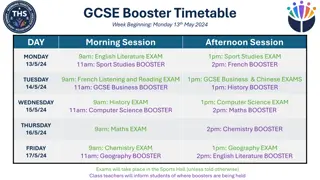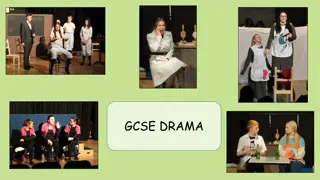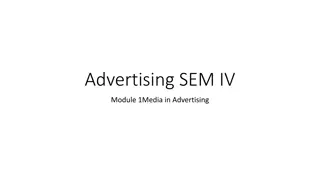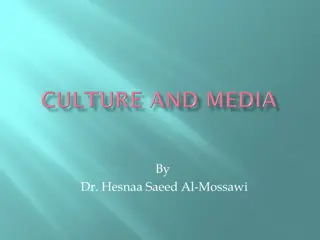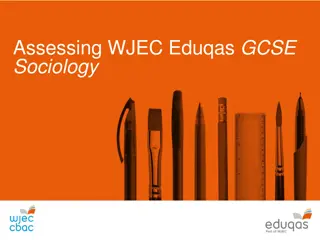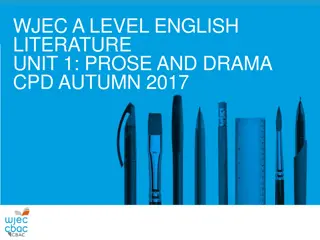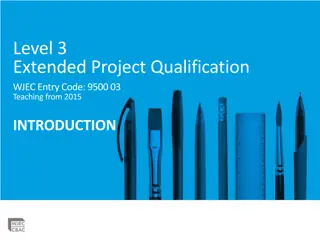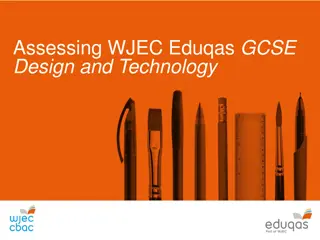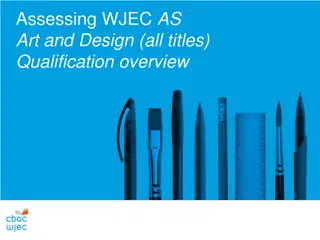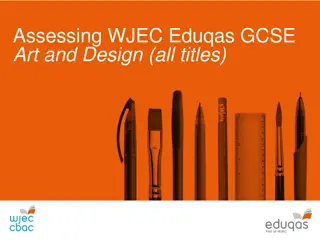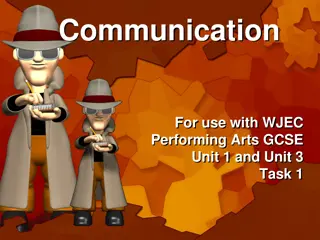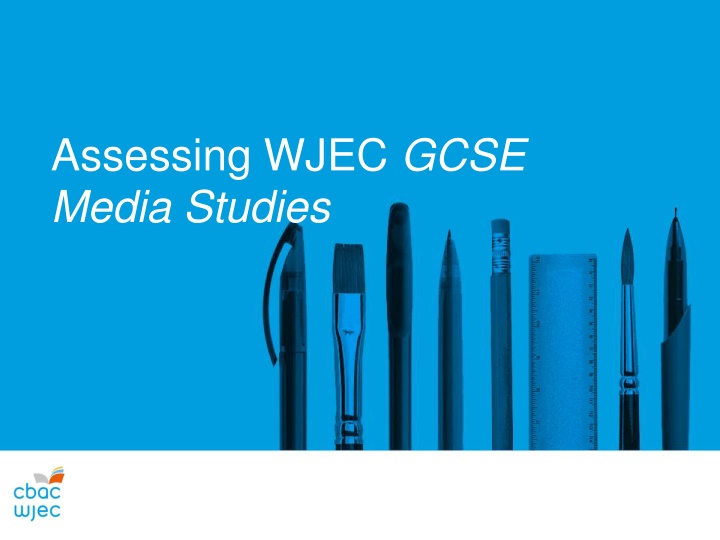
WJEC GCSE Media Studies Assessment Criteria
Exploring the assessment criteria for WJEC GCSE Media Studies, including marking schemes, academic judgment, use of subject terminology, and addressing rubric infringements to ensure fair evaluation. Learn how to assess evidence effectively in student responses.
Download Presentation

Please find below an Image/Link to download the presentation.
The content on the website is provided AS IS for your information and personal use only. It may not be sold, licensed, or shared on other websites without obtaining consent from the author. If you encounter any issues during the download, it is possible that the publisher has removed the file from their server.
You are allowed to download the files provided on this website for personal or commercial use, subject to the condition that they are used lawfully. All files are the property of their respective owners.
The content on the website is provided AS IS for your information and personal use only. It may not be sold, licensed, or shared on other websites without obtaining consent from the author.
E N D
Presentation Transcript
Assessing WJEC GCSE Media Studies
Assessing evidence Understanding the assessment criteria Marking criteria generally take two forms: objective marking- generally for low tariff responses, where knowledge of objective information is being assessed the exercising of academic judgement via: an assessment grid setting out criteria for different levels of response indicative content, that is, an indication of the kind of content responses may include.
Assessing evidence Understanding the assessment criteria exercising academic judgement through levels of response marking schemes First - identify the appropriate band a learner s response falls into according to the criteria. Award a band where the learner s response covers the majority of the criteria. Second - award a mark in the centre of the band and then increase or decrease the mark depending on the quality of the answer, which may be reflected in the amount of indicative content covered. If a response falls between two bands, consider whether there are more characteristics of the higher or lower of the two bands and award accordingly. Indicative content is not exhaustive and other valid responses may be credited.
Assessing evidence Use of subject terminology. Use of appropriate terminology is rewarded within the marking criteria. Unless there is a specific requirement within a question, learners may also be awarded marks where the answer is accurate but expressed in their own words. Use of subject terminology can be rewarded in exam responses (particularly those with a higher tariff) and research and evaluation of NEA.
Assessing evidence Rubric infringements WJEC has a consistent way of addressing rubric infringements across all our qualifications. Below is a list of the possible infringements which sometimes occur for this qualification Type of infringement Action Answering more than the stipulated number of questions Mark all optional questions that the learner has attempted. Determine which of the attempted routes through the rubric elicits the highest mark. Award highest mark. Ticking/indicating more than the stipulated number of answers Mark all responses offered by the learner. Total the number of marks Deduct one mark for every additional response circled over the number stipulated in the question.
Assessing evidence Rubric infringements Type of infringement Action Incorrect numbering of an answer (unconstrained papers) If it is obvious which question is being answered, award marks as per the marking scheme for the question focused on by the candidate. If there is creditworthy material relevant to both questions 7 and 8, under question 8, award marks for the question 8 and where possible consider additional information for question 7 if question 7 has not been attempted. Do not double credit for both question 7 and 8. Where the correct answer has been clearly crossed out. If the learner writes and then crosses out the correct answer, do not award the mark, even if no other answer is offered.
Assessing evidence Assessment Purpose Unit 1: Unit 1 provides an important foundation for analysing media products Learners will develop their ability to analyse meanings and representations within media products and industries Unit 2*: Unit 2 involves the in-depth study of two media forms: television and Hollywood film Learners will gain a deeper knowledge and understanding of key media concepts - media language, representation, media industries and media audiences. *This year it is expected that candidates may have studied a selection of the above rather than all Unit 3: This unit requires learners to develop and apply their knowledge and understanding of media key concepts to a practical production.
Assessing evidence Assessment Criteria: Units 1 & 2 Band 5: Excellent MEANS detailed analysis, concise & focused the response answers the question, demonstrates confident use of terminology, and consistent display of knowledge and understanding Band 4: Good MEANS reasonably detailed analysis the response is focused on question, there is good use of terminology, the response displays regular knowledge and understanding Band 3: Satisfactory MEANS there are some key points of analysis, the response focuses on question, there is some use of terminology, and knowledge and understanding is evident Band 2: Basic MEANS that there is one or two points of analysis, some relevance to question, knowledge and understanding is straightforward or common-sense Band 1: Minimal MEANS that there is vague analysis, absence of knowledge and understanding, the response is short, incomplete or barely attempted.
Assessing evidence Characteristics of a successful textual analysis response (i.e. Unit 1 Section A) A successful response: Has excellent use of subject specific terminology Clear, specific links to the stimulus material (where appropriate) Engages in wider debate on media concept (representation and audience in this case) See OER 2019, Section A Example 1 The hero is strong, fit and attractive. The alpha male stereotype is to be strong and this video game cover promoted this representation. The man is perfect and may make male gamers feel like they aren t strong enough or that they aren t perfect.
Assessing evidence Characteristics of a less successful textual analysis (i.e. Unit 1: Section A) A less successful response: Ignores the stimuli or makes vague reference (if appropriate) Makes sweeping generalisations Shows a common-sense understanding of the media concepts being tested by the question Uses minimal subject terminology See OER 2019, Section A, Example 3
Assessing evidence Characteristics of a successful industry-focused response (i.e. Unit 1 Section B, Unit 2 Sections A or B) A successful response: Makes specific reference to case studies Case studies are written about in a detailed and thorough way Engages in relevant discussions about media representations and audiences Stays focused on the question Develops or attempts to develop an argument or take a view Uses appropriate subject specific terminology See OER, Unit 2: Question 1d - Example 1 or Question 3 - Example 1
Assessing evidence Characteristics of a less successful industry-focused response (i.e. Unit 1 Section B, Unit 2 Sections A or B) A less successful response: Makes vague or minimal reference to case studies Straightforward or common-sense understanding of media representations and audiences Strays from the question a downloaded response Uses minimal subject terminology See OER, Unit 2: Question 3 - Example 3 or Question 1d - Example 1
Any Questions? If you have any questions, contact our specialist subject officers and administrative support team for your subject with any queries: media@wjec.co.uk


